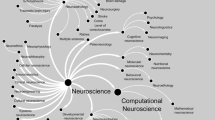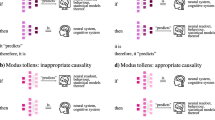Abstract
Knowledge about the brain and the human nervous system ultimately relates to human thought, perception, and behavior. People use natural languages like English to talk about “common sense” concepts, but the brain processes that produce them are described in a highly technical vocabulary. BrainSpace tries to relate technical concepts in anatomy and chemistry to a general body of common sense knowledge, Open Mind Common Sense. It uses the novel inference technique of Blending, to perform joint inference between technical neuroscience knowledge and common sense knowledge, and vice versa. The current paper reports preliminary results showing that BrainSpace’s inference organizes concepts such as the “visual brain,” “dynamic brain,” and deep brain stimulation in an intuitively plausible manner, indicating that it can serve as a foundation for interpreting more specific experimental and medical data.






Similar content being viewed by others
References
Alonso J. PerspectiveSpace. Massachusetts Institute of Technology, 2008.
Alonso J, Havasi C, Lieberman H. PerspectiveSpace: opinion modeling with dimensionality reduction. In: Conference on user modeling, adaptation and personalization (UMAP-09), Trento, 2009.
Arnold K, Lieberman H. Managing ambiguity in programming by finding unambiguous examples. Reno, NV, USA: ACM Onward/SPLASH conference; 2010a.
Arnold K, Lieberman H. Cross-domain scruffy inference. Washington, DC: AAAI fall symposium on commonsense knowledge; 2010b.
Cambria E, Hussain A, Havasi C, Eckl C. AffectiveSpace: blending common sense and affective knowledge to perform emotive reasoning. Massachusetts Institute of Technology, 2009.
Carter R. The human brain book. New York: DK Publishers; 2009.
Embracing Ambiguity, Arnold K, Lieberman H. Association for Computing Machinery Special Interest Group on Software Engineering. NM, USA, November: Santa Fe; 2010.
Fensel D, Hendler J, Lieberman H, Wahlster W. Spinning the semantic web. Cambridge, MA: MIT Press; 2003.
Gold K, Havasi C, Anderson M, Arnold K. Comparing matrix decomposition methods for meta-analysis and reconstruction of cognitive neuroscience results. In: 24th conference of the Florida artificial intelligence research society (FLAIRS), Palm Beach, FL, 2011.
Havasi C, Pustejovsky J, Speer R, Lieberman H. Digital intuition: applying common sense using dimensionality reduction. IEEE Intell Syst. 2009;24(4):24–35. Special issue on human-level intelligence.
Hodaie M, Wennberg RA, Dostrovsky JO, Lozano AM. Chronic anterior thalamus stimulation for intractable epilepsy. Epilepsia. 2002;43(6):603–8.
Just MA, Cherkassky VL, Aryal S, Mitchell TM. A neurosemantic theory of concrete noun representation based on the underlying brain codes. PLoS One. 2010;5(1):e8622. doi:10.1371/journal.pone.0008622.
Kandel E, Schwartz JH, Jessell T. Principles of neural science. New York: McGraw-Hill Medical; 2000.
Lieberman H, Smith D, Teeters A. Common consensus: A web-based game for collecting commonsense goals. Workshop on common sense for intelligent interfaces, ACM international conference on intelligent user interfaces (IUI-07), Honolulu, January 2007.
Pereira EA, Muthusamy KA, De Pennington N, Aziz CATZ. Deep brain stimulation of the pedunculopontine nucleus in Parkinson’s disease. Preliminary experience at Oxford, 2008.
Singh P, Lin T, Mueller ET, Lim G, Perkins T, Zhu W-L. Open mind common sense: knowledge acquisition from the general public. In: Proceedings of the 1st international conference on ontologies, databases, and applications of semantics for large scale information systems, Irvine, CA, USA, 2002.
Speer R, Havasi C, Lieberman H. AnalogySpace: reducing the dimensionality of commonsense knowledge. In: Conference of the association for the advancement of artificial intelligence (AAAI-08), Chicago, July 2008.
Speer R, Havasi C, Treadway N, Lieberman H. Finding your way in a multi-dimensional semantic space with luminoso. In: ACM international conference on intelligent user interfaces (IUI), Hong Kong, China, February 2010, p. 385–8.
Wingeier B, Tcheng T, Koop MM, Hill BC, Heit G, Bronte-Stewart HM. Intra-operative STN DBS attenuates the prominent beta rhythm in the STN in Parkinson’s disease. Exp Neurol. 2006;197:244–51.
Acknowledgments
We thank Ed Boyden, Kevin Gold, Mark Marchionni, Marvin Minsky, and Sebastian Seung,Elizabeth Hawkins, Catherine Havasi, Kenneth C. Arnold for contributing their advice and expertise in neuroscience. We gratefully acknowledge the support of the MIT Mind-Machine Project (MMP).
Author information
Authors and Affiliations
Corresponding author
Rights and permissions
About this article
Cite this article
Howard, N., Lieberman, H. BrainSpace: Relating Neuroscience to Knowledge About Everyday Life. Cogn Comput 6, 35–44 (2014). https://doi.org/10.1007/s12559-012-9171-2
Received:
Accepted:
Published:
Issue Date:
DOI: https://doi.org/10.1007/s12559-012-9171-2




